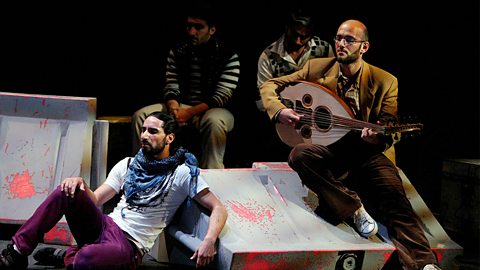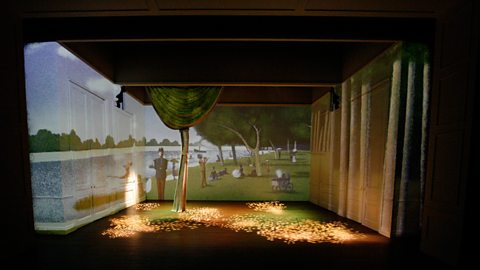Scenic devices - drapery, levels, projections and flats
Set designers use a range of scenic devices to convey their design ideas.
Drapery
There are different types of curtains that are used for different purposes:
- backdropA section at the back of the stage that can be painted or projected onto. (also called a backcloth) - a piece of cloth hung behind the stage in a theatre as part of the scenery that can be painted or have coloured light or projections shone onto it
- borders - wide and short drapes that mask the top of the stage where lights are hung
- gauze (also called a scrim) - a thin curtain that can be lit either from the front to make it opaque, or from behind to make it transparent
- legs - long and narrow drapes used to mask the wingsThe side areas that lead off the stage. space
- tabs - the name for stage curtains that can open horizontally or fly vertically
- ground row - a long, low piece of stage scenery, built to simulate part of a landscape. It is sometimes used to conceal lanterns from the audience
- iron - a safety curtain designed to prevent stage fires spreading into the auditoriumA place where the audience are situated to see and hear the performance.
Levels
A set designer can vary levels through the use of rostraA stationary platform for performers to stand on., ramps and steps. Ordinary blocks, staging units, scaffolding and planks can be used to create levels and can be joined together to create steps or other shapes. Levels are often used in productions to portray a character’s status, power or situation.

Projections
Projections are becoming more common within set design and can be used to add detail and texture on stage. In some venues scenery can be projected, which can be very effective but can have limitations. For example, unless it can be projected from behind the set, actors will cast shadows onto it.

Flats
A flatWood or framed canvas used to create a background for a performance. is a piece of scenery used to represent a wall or to conceal a backstage area. A series of flats can be joined together to make a runA number of flats joined together., where each flat is supported by a braceAn adjustable support for a stage flat. with a heavy weight attached.